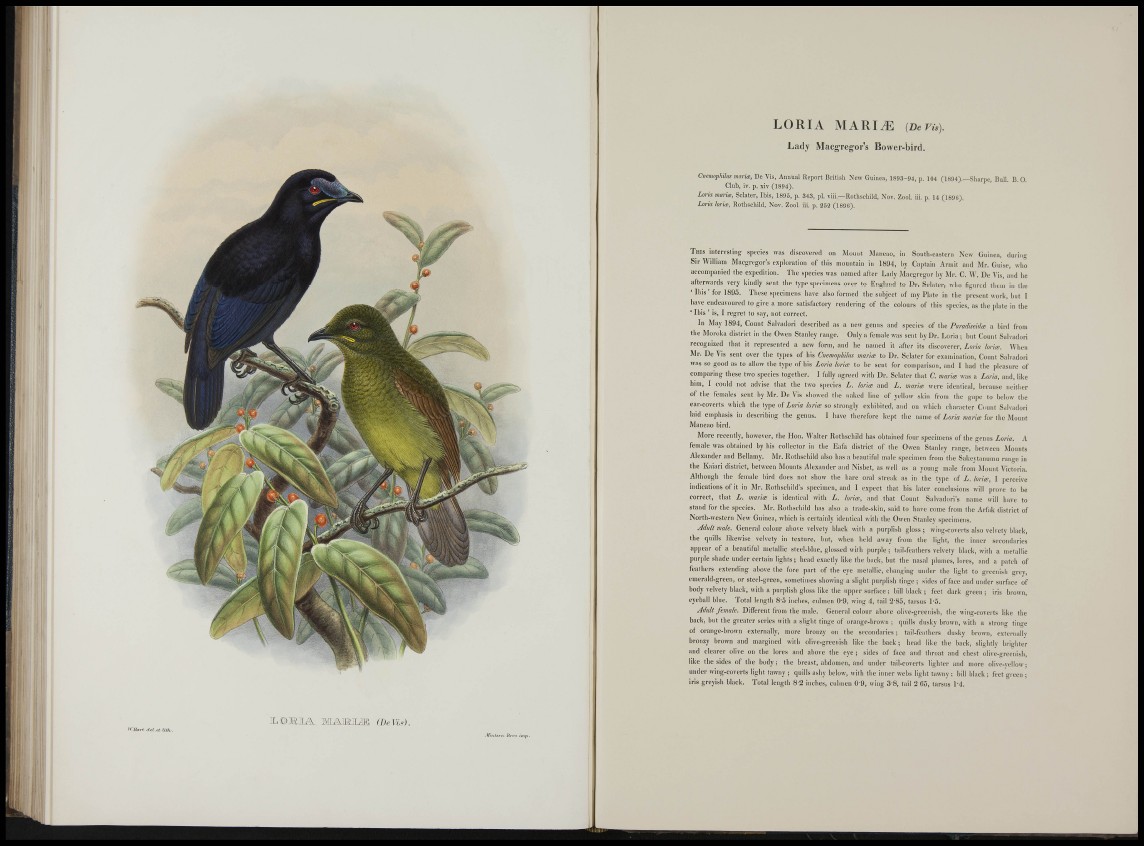
jL®3S.Xì3L MiMaiLsB (De Vi.--).
irziiiry fiel el l i t / i .
.Wmici-ti Hrv.' ¡rnjt.
LORIA MARIiE (DeVis).
Lady Macgreg'or's Bower-bird.
CnemopMlus maria:, De Vis, Animal Report British New Guinea, 1893-94, p. 104 (1894).—Sharpe, Bull. B. 0.
Club, iv. p. XÌT (1894).
Lm-ia ma ry, Sclater, Ibis, 1895, p. 343, pi. -viii.—Rothschild, Nov. Zool. iii. p. 14 (1896).
Loria loriiB, Rothschild, Nov. Zool. iii. p. 252 (189(i).
THIS interesting spccies was discovered on Mount Maneao, in South-eastern New Guinea, during
S i r William Macgregor's exploration of tliis mountain in 1804, by Captain Ar.nit and Mr. Guise, who
accompanied the expedition. The species was named after Lady Macgrcgor by Mr. C. W. De Vis, and be
a f t e r w a r d s very kindly sent tlie type specimens over to England to Dr. Scbiter, wlio figured tliem in the
' Ibis' for 1895. These specimens have also formed the subject of my Plate in the present work, but I
have eiideavoured to give a more satisfactory rendering of the colours of this species, as the jilate in the
' Ibis ' is, I regret to say, not correct.
In May 1894, Count Salvadori described as a new genns and species of the Paradiseida: a bird from
t h e Moroka district in the Owen Stanley range. Only a female was sent by Dr . Lor ia; but Count Salvadori
recognized that It represented a new form, and he named It after its discoverer, Loria lurice. When
Mr. De Vis sent over the types of his Cnemophihs marice to Dr. Sclater for examination. Count Sahadori
was so good as to allow tlie type of his Loria lorice to be sent for comparison, and I had tbe pleasure of
c o m p a r i n g these two species together. I fidly agreed with Dr. Sclater that C. mariai was a Loria, and, like
him, I coidd not advl.se that tbe two species L. lorice and L. marite were Identical, because neither
of tbe females sent by Mr. De Vis showed the naked line of yellow skin from the gape to below tbe
e a r - c o v e r t s which tbe type of Loria loriw so strongly exhibited, and on wbich character Count Salvadori
laid emphasis in describing tbe genus. I have therefore kept the name of i o m man'« for tbe Mount
Maneao bird.
More recently, however, tbe Hon. Walter Rothschild has obtained four specimens of the genus Loria. X
female was obtained by bis collector in the Eafa district of the Owen Stanley range, between Mounts
Alexander and Bellamy. Mr. Rothschild also has a beautiful male specimen from tbe Sakeytanumu range In
t h e Kaiari district, between Mounts Alexander and Nisbet, as well as a young male from Mount Victoria.
Although the female bird does not show the bare oral streak as In tbe type of L, lorias, I perceive
indications of it in Mr. Rothschild's specimen, and I expect that bis later conclusions will prove to be
c o r r e c t , that L. mariw is identical with L. loria;, and that Count Salvadorl's name will have to
stand for tbe species. Mr. Rothschild has also a trade-skin, said to have come from tbe Arfak district of
N o r t h - w e s t e r n New Guinea, which Is certainly Identical with the Owen Stanley specimens.
Adult male. General colour above velvety black with a purplisli gloss ; wing-coverts also velvety black,
t h e quills likewise velvety hi texture, but, when held away from tbe light, tbe Inner secondaries
apiiear of a beautiful metallic steel-blue, glossed with jiurple ; tail-feathers velvety black, with a metallic
p u r p l e shade under certain lights; bead exactly like the back, but tbe nasal plumes, lores, and a patch of
f e a t h e r s extending above tbe fore part of tbe eye metallic, changing under tbe light to greenish grey,
emerald-green, or steel-green, sometimes showing a slight purplish tinge ; sides of fiice and under surface of
body velvety black, with a purplish gloss like the upper surface ; bill black ; feet dark green ; iris brown,
eyeball blue. Total length 8-0 inches, culmen 0-9, wing 4, tall 2-85, tarsus I'O.
Adult female. Different from tbe male. General colour above ollve-greeiiisb, the wing-coverts like the
back, but the greater series with a slight tinge of orange-brown ; quills dusky brown, with a strong tinge
of orange-brown externally, more bronzy on the secondaries; tail-feathers dusky brown, externally
bronzy brown and margined with olive-greenish like the back ; head like tbe back, slightly brighter
and clearer olive on tbe lores and above the eye ; sides of fiice and throat and chest olive-greenish,
like the sides of tbe body; tbe breast, abdomen, and under tail-coverts lighter and more olive-yellow;
nnder wing-coverts light tawny ; quills ashy below, with tbe Inner webs light tawny : bill black ; feet green ;
iris greyish black. Total length 8-2 inches, culmen 0 9, wing 3 8, tall 2 65, tarsus 1-4.